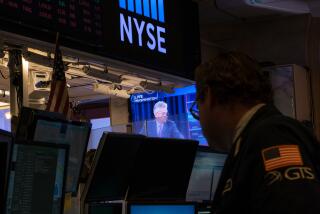Muni bonds catch a break
The municipal bond market stabilized in the first quarter after a harrowing slump in the final months of 2010, but investors probably shouldn’t get used to the relative calm.
Bonds in general are likely to face more volatility this year, and the muni market could again bear the brunt of it — particularly in struggling economies such as California’s.
“Things are still very tenuous,” said Joe Gotelli, co-manager of the American Century California Intermediate-Term Tax-Free Bond fund in Mountain View, Calif.
That also could mean opportunity for yield-hungry investors.
The average mutual fund that owns long-term California muni bonds had a negative “total return” of 0.7% in the quarter that ended March 31, according to Lipper Inc. Total return measures the change in a fund’s share price plus any interest or dividend income paid.
When a bond fund’s total return is negative, it means the drop in the portfolio’s value in the period — as reflected in the share price — more than offset whatever interest was earned.
Although many muni funds were in the red in the first quarter, their performance improved sharply from the fourth quarter, when the average long-term California muni fund lost 5.8%.
Most other categories of bond funds eked out positive total returns last quarter.
The problem for most bond sectors since October has been rising market interest rates, as investors have demanded higher yields on newly issued securities.
When market rates go up, existing bonds automatically lose some of their value because their fixed-rate returns are relatively less attractive compared with yields on new bonds.
Some of the rebound in longer-term interest rates since last fall has stemmed from investors’ sense that the economy was improving. But in the muni market, other concerns also began to push market rates higher — including worries that the deepening budget woes of many state and local governments would lead to widespread bond defaults, meaning that issuers would fail to make promised payments to bondholders.
Those fears were fanned by star Wall Street banking analyst Meredith Whitney, who in late December predicted on national TV that the muni market would be slammed by “50 to 100 sizeable defaults” in 2011 totaling “hundreds of billions of dollars’ ” worth of bonds.
That was a stunning forecast, because muni defaults historically have been a tiny sliver of the $2.8-trillion market. The one-year record for defaults was $8.2 billion in 2008.
Whitney’s warning helped trigger a vicious cycle in the muni market: Some mutual fund investors bailed out, forcing fund managers to sell bonds, which in turn further depressed bond values and drove up interest rates, fueling more losses and more selling.
By Jan. 18 the annualized tax-free yield on the Bond Buyer newspaper’s index of 40 long-term muni bonds nationwide reached 5.95%, a two-year high and up from 4.86% in mid-October. That’s a huge rate move for a three-month period.
But yields have pulled back since mid-January as selling pressure in the muni market has eased. The Bond Buyer index yield was 5.72% on Friday.
More money still is leaving muni bond funds than is going in, overall, but redemptions have slowed. The funds, which now hold about $455 billion in bonds, had net redemptions of $465 million in the seven days ended March 30, down from a peak weekly outflow of $5.7 billion in mid-January.
Some investors have been encouraged that the default wave forecast by Whitney has failed to materialize. A total of $671 million in muni bonds have defaulted year to date nationwide, a far cry from Whitney’s “hundreds of billions” call, said Matt Fabian, senior analyst at research firm Municipal Market Advisors in Concord, Mass.
Although it’s still early in the year, “I don’t know anyone who’s still taking her seriously,” Fabian said.
But analysts acknowledge that many investors remain wary of munis, despite lucrative tax-free yields. The market’s turnaround in the first quarter was less a story of strong investor demand than of a dwindled supply of new bonds, as many states and local governments halted borrowing.
“The market feels as if it has stabilized, but a lot can be attributed to the fact that there’s little supply,” said Dino Mallas, manager of the T. Rowe Price California Tax-Free Bond fund.
To save money, cash-strapped California in January nixed plans to issue what might have been several billion dollars’ worth of voter-authorized bonds for infrastructure projects in the first half of this year.
While the vast majority of state and local governments are likely to make good on their debts barring another economic meltdown, analysts warn that headlines about financially troubled municipalities are likely to increase this year — in part because states are balancing their own budgets on the backs of counties, cities, school districts and other local government units.
“Credit quality will continue to get worse,” Fabian said, referring to the perception of many muni bond issuers’ financial strength.
That’s a particular risk in California, where Democrats and Republicans once again are deadlocked on how to patch the state’s gaping budget hole.
Besides its specific challenges, the muni bond market this year will face the bigger picture of Federal Reserve interest rate policy. If the Fed begins to tighten credit, all interest rates could rise, depressing the prices of older fixed-rate bonds.
All of this could make for more wild swings in muni bonds, a market that traditionally was fairly stable. “The market is going to be susceptible to volatility,” said American Century’s Gotelli.
For California muni fund owners and potential investors, here are three things to consider:
• If you’re in a fund now, are you comfortable with the risk?
If your goal was to earn tax-free income, you’re still earning it. And the advantage of funds over individual bonds is that you own a diversified portfolio monitored by your fund manager.
One big disadvantage: You’re at the mercy of your fellow shareholders. If they flee, your fund may be forced to sell bonds, which could hurt your returns.
If your fund’s share price fell further than you thought possible in the winter sell-off, consider moving to a fund that owns short- or intermediate-term bonds. Your interest earnings will be lower, but you’ll lose less principal if market interest rates rise again.
The share price of the American Century California Intermediate-Term Tax-Free fund, for example, fell 5.1% from last Sept. 30 to March 31, while the company’s long-term California fund fell 7.5%.
The trade-off: The intermediate-term fund pays an annualized tax-free yield of about 3.8% currently, versus about 4.7% for the long-term fund.
• Do you know what you own?
If you look inside your fund’s portfolio, the individual bonds may not mean much to you. But you should at least read the latest report from the fund to understand the strategy it pursues.
Chris Ihlefeld, co-manager of the Thornburg California Limited Term Muni fund, says he has been hunting for bonds that don’t have the highest-quality, AAA credit ratings but whose true quality may be underestimated by other investors.
“There is a whole swath of single-A credits that are very good” in California, he said, including certain local school district issues.
To reduce risk, some funds are focusing heavily on revenue bonds, which are backed by income generated by specific projects, such as power plants or water facilities, rather than general tax receipts.
Mallas at T. Rowe Price said his California fund has more than 80% of assets in revenue issues.
• If you’re thinking about buying munis, weigh current yields against other options.
Tax-free muni yields remain attractive for high-tax-bracket Californians.
A California muni fund yielding 4% in tax-free interest is paying the equivalent of a taxable bond investment paying 6.1% for someone in the combined federal and state tax bracket of 35%, which begins at taxable income of about $137,000 for couples.
Fabian, however, worries that with the pullback in yields since January, “They’re too low for retail investors to get excited about.” And because the muni market is heavily dependent on individual investors’ buying, if they turn away again, yields might have to climb sharply in a hurry.
That’s an argument for keeping some powder dry for better opportunities to buy munis, especially if you think interest rates in general are headed higher.






